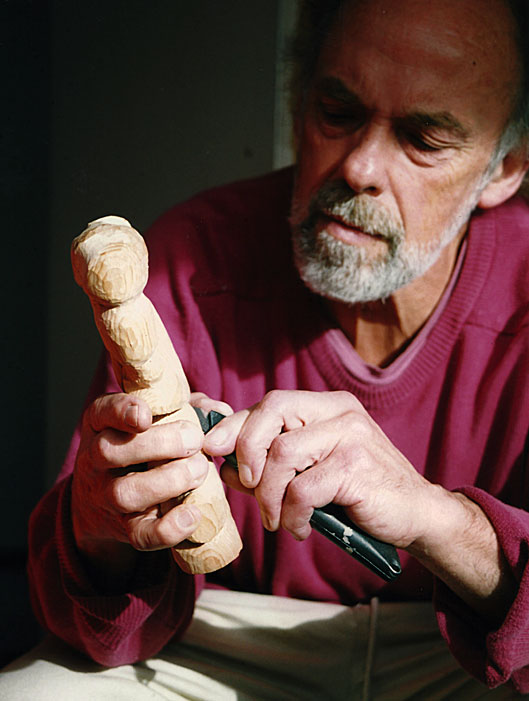We have to understand that the world can only be grasped by action, not by contemplation. The hand is more important than the eye … The hand is the cutting edge of the mind.
— Jacob Bronowski, The Ascent of Man, Episode 3 “The Grain in the Stone”. (1)
Getting into a state of “Flow”
Every so often, I find I have to take time out from the world of words and abstract concepts: sharing ideas, negotiating, imagining, listening and discussing things. I most easily enter that happy state of flow where time disappears and I become absorbed (2) , when I’m silently and contentedly alone, non-verbally doing something in a concentrated way – and most often when I’m using my hands, where I can see that what I’m doing with them matters.It could be playing a musical instrument, painting a picture, doing a martial arts move, making clothes, building a piece of furniture; even – heaven forbid – cleaning! I find it so enjoyable to attend to, and adjust the subtle movements, strength and pressure of fingers and thumbs to co-ordinate actions with mental intention and to allow the tactile feedback to influence my thinking. It empowers and satisfies, creates a direct experience of something real in the here and now that feeds my mind, enriches my imagination. Often I have my strongest ideas and insights when I’m handling something, or trying to negotiate a tricky task that requires precision and manual dexterity.
I’m one of those people Susan Cain talks about in her book “Quiet: The power of introverts in a world that won’t stop talking” (3) who get more energy when they are alone, and drain of energy like a battery in what we’d commonly call “extrovert” settings. And of the three learning style preferences described in Neuro Linguistic Programming (Auditory, Visual, Kinesthetic), I have strong preferences for the visual and kinesthetic styles – learning by seeing and doing (4). You may have different personality and learning preferences, so I wonder what role thinking with your hands has for you?
Hand and Brain together
Can you imagine not having hands? That thought experiment should be enough to convince us that we’re really quite helpless to engage with the world without them, practically and otherwise. Our hands are the main structures we have for physically manipulating our environment – we are anatomically primed to engage with the world through our hands together with the brain. The fingertips, for example, have about 4000 nerve endings – one of the densest area of nerve endings on the body – and larger areas of the brain’s cortex are devoted to sensations from the hands (and lips) than other parts, such as the torso.
 It should be no surprise to us, therefore, when we read Bronowski’s quotation above: we can resonate with, and be inspired by his view that our hands can lead our mind; spearheading, as well as providing the outlet for, our thinking. Bronowski goes further and says that it is learning with the hands “that drives the evolution of the brain“, whether as prehistoric toolmaker, or in the present day, and that “the march of man is the refinement of the hand in action“.
It should be no surprise to us, therefore, when we read Bronowski’s quotation above: we can resonate with, and be inspired by his view that our hands can lead our mind; spearheading, as well as providing the outlet for, our thinking. Bronowski goes further and says that it is learning with the hands “that drives the evolution of the brain“, whether as prehistoric toolmaker, or in the present day, and that “the march of man is the refinement of the hand in action“.
Set against this, however, is the background belief, and evidence in our social structures, that working with one’s hands is somehow inferior to abstract intellectual abilities and separate from them. This does not square with this view, or with my experience.
So where does this view come from and does it have validity?
Views about the relationship of mind and body
In the Eastern mind training traditions, learning and perfecting a physical art through repeated practice is a prerequisite to further mental development. In Zen, the pupil who wants to learn the secrets of the mind has first to prove that they have mastered one of the physical arts: a martial art, flower arranging, archery. It is not until they have gained the discipline, attentiveness and unification of mind and body that comes from doing this, that practitioners are deemed to be ready to advance to meditation and the mental gymnastics of grappling with a Koan. In other words, developing and refining physical awareness and skill to a high degree, comes first.
By contrast, in the West, our longstanding belief has been of the mind and body as separate, with the former being prominent. Since ancient Greece, the concept of a Platonic ideal where the mental world has a separate, generalised, transcendant quality has prevailed. This was reinforced when Rene Descartes and Francis Bacon espoused a rational tradition with the notion of “I think therefore I am“, which relied solely on mental reasoning as the only vehicle to show truth. This tradition still influences us, and has informed the way our society has developed.
Evidence in our social structures
We have somehow woven into our social structures the belief that “doing” is an inferior activity to “thinking” – rather than integrally linked to it. In “primitive” times, people lived in tribal communities where everyone took part in all the activities of life: cooking, hunting, dancing. As hierarchical cultures developed, Kings, Feudal Lords and today, Corporate Leaders and Politicians, emerged to rule over serfs, labourers and employees. Society is largely divided into those who “say” and those who “do”, mirroring the split between mind and body on a larger scale.
In our professional lives, generally, those who think about what to do, talk, and tell others what to do are afforded more status and resources than those who work with the objective world – with all the limitations, challenges and obstacles that that entails. They are seen to be merely carrying out orders – as if that doing is an afterthought, when it is often the thing in itself. Ministers, Managers and Marketeers are the “brains”, Civil Servants, Workers and Engineers are the “hands”, mirroring the messages and belief in our culture that to do is to be less.
This is backed up by our education system: academic subjects are seen to more important than practical ones, with art, music and dance – subjects that engage our physical organism more fully – consigned to the bottom of the curriculum, as Ken Robinson so wonderfully describes in his TED talk on “How schools kill creativity” (5).
Now, in our digital world and with machine components and consumer goods so specialised, cheap, and ubiquitous, we are all beginning to find ourselves with our own digits proverbially behind our backs, disarmed in a culture where there is less and less need or rationale to learn to mend, repair, grow or make things.
Turning the tide
Given the outline above, is it any wonder that I have the nagging feeling (you may share with me) that enjoying making and doing things with my hands, as one of the ways in which I can engage meaningfully with the world, is something to be wary about owning up to?
This cultural dimissal of handiwork may, however, be having an impact on our skills and ability to think in ways that are important in solving some of our problems. Some evidence to suggest that it may, and hence that changes in attitudes are needed, has emerged:
-
- At NASA’s Jet Propulsion Laboratory, it has become apparent that today’s engineers are far less able to solve problems than those of previous years: “Engineers who had worked and played with their hands as they were growing up were able to ‘see solutions’ that whose who hadn’t worked with their hands could not“. (6) The pertinent example that shows the importance of this is when engineers at NASA succeeded in improvising a carbon dioxide filter from a variety of random materials for the Apollo 13 mission and communicating that to the astronauts onboard, thus saving their lives.
- “Design Thinking” as an essential business competence has grown in popularity. A main proponent, Marty Neumeier, describes the problem that what we can know is limited to “what is or was” while innovation and designing the future are all about “what is possible” and hence “the design process inserts a middle step: making“. This, Neumeier says, will help us succeed “in the post-industrial era (which) demands that we move our thinking from the static, the linear, and the step-by-step to the dynamic, the holistic, and the all-at-once.” “Making” is hence included in his “Five Metaskills for the Robotics Age“. (7)
- Research into the role of gestures in learning (Susan Goldin-Meadow, Professor of Psychology at the University of Chicago) has revealed the significance of gesturing with our hands and concluded that “we change our minds by moving our hands“. (8)
It seems a recent book on the topic “The case for working with your hands: why office work is bad for us, and fixing things feels good.” has even found its way into the in-tray of Michael Gove, the Secretary of State for Education (9). Perhaps a sea-change in opinion and attitudes could follow from a revised education curriculum which reconnects the brain to the hand.
Better Thinking Everywhere
For our Fellowship of Mind, I’d therefore advocate that we put developing expertise with our hands firmly and squarely on the agenda. The “better thinking” we propose isn’t the heady, cerebral, generalised kind: it’s what we do as embodied beings with a particular body, at a particular time and place as individuals trying to get a grasp on the world in order to know what to do. We act in, and are an integral part of it, connecting to our environment by what we do with, and how we use, our hands.
 We might not need to be quiet to “think with our hands”, but we can pay greater attention to what we are doing with them every moment and when we have the opportunity to develop and refine our hands-on skills, we may wish to. For our office jobs, for example, we could learn to touch type with all ten digits, if we can’t already (try Mavis Beacon software – that’s fun!), and maybe sometimes build, make and mend. In so doing, perhaps we can initiate a different kind of “digital revolution” that puts the power back into our own hands.
We might not need to be quiet to “think with our hands”, but we can pay greater attention to what we are doing with them every moment and when we have the opportunity to develop and refine our hands-on skills, we may wish to. For our office jobs, for example, we could learn to touch type with all ten digits, if we can’t already (try Mavis Beacon software – that’s fun!), and maybe sometimes build, make and mend. In so doing, perhaps we can initiate a different kind of “digital revolution” that puts the power back into our own hands.
It is so helpful, over and over, to come up short when faced with bringing about change in the objective physical world and find that things don’t work out the way we expect them to. It helps us to appreciate that reality doesn’t bend to our ideas and cannot be visualised into existence: it has to unfold bit by bit, through accurate and relevant actions and processes, experience that helps with our “Better Thinking Together“.
Sophie Brown
References
1) More information about Jacob Bronowski’s acclaimed 13 part television series and the book “The Ascent of Man“. See the film excerpt (from 40.17 – 43.44 minutes) for the full piece from which this quotation is taken, where Bronowski speaks in front of Henry Moore’s Sculpture “The Knife Edge“.
2) “Flow” as described by Mihaly Csikszentmihaly in the seminal book: “Flow: The Psychology of Happiness: The Classic Work on How to Achieve Happiness“.
3) “Quiet: The Power of Introverts in a World that won’t stop Talking” – by Susan Cain. See her TED talk too:
4) The “VAK” system of NLP which has been developed further to include finer distinctions.
5) Ken Robinson TED video: “How schools kill creativity”
6) Quoted on Page 9 in “Play – How it shapes the brain, opens the imagination and Invigorates the soul” by Stuart Brown
7) See “The Designful Company” and “Five Metaskills for the Robotics Age” by Marty Neumeier. For a description of Neumeier’s process see “Know, Make, Do“.
8) Susan Goldin-Meadow, review of research in the journal, Cognitive Science. See also a blog piece by Annie Murphy Paul: How to think with your hands
9) “The case for working with your hands: why office work is bad for us, and fixing things feels good.” by Matthew Crawford 2009. Reference to Mr Gove is in this editorial review.
Photo credits
Photographs of 1) Adrian West sewing, and 2) Graham K. Brown woodcarving – copyright c. Sophie Brown 2013. Photographs of Lathe operator from 1942, and hands typing from Wikipedia, both in the public domain.

